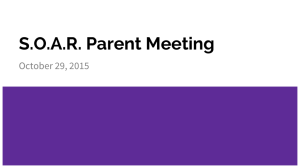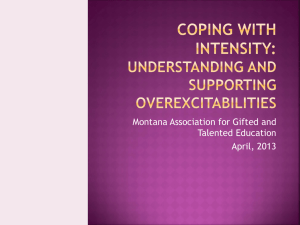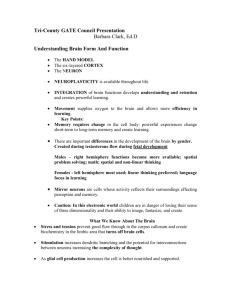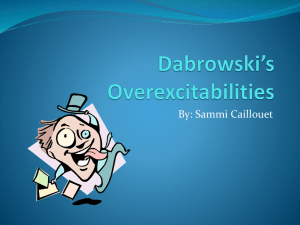Highly Gifted, Highly Sensitive, and Highly Intense by
advertisement
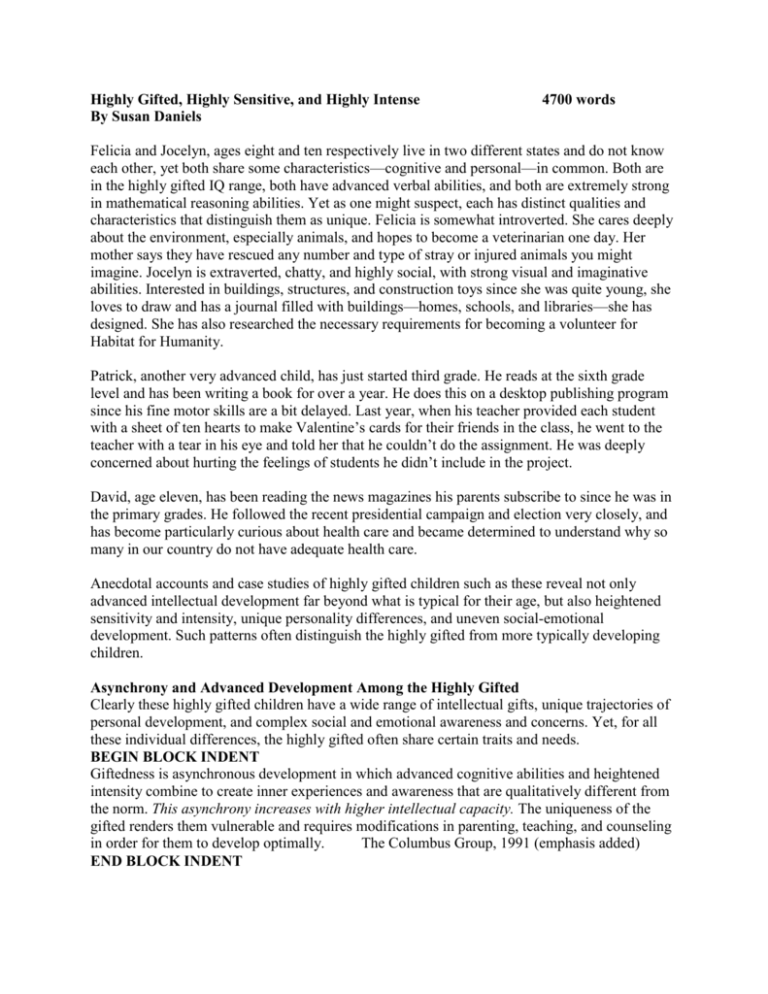
Highly Gifted, Highly Sensitive, and Highly Intense By Susan Daniels 4700 words Felicia and Jocelyn, ages eight and ten respectively live in two different states and do not know each other, yet both share some characteristics—cognitive and personal—in common. Both are in the highly gifted IQ range, both have advanced verbal abilities, and both are extremely strong in mathematical reasoning abilities. Yet as one might suspect, each has distinct qualities and characteristics that distinguish them as unique. Felicia is somewhat introverted. She cares deeply about the environment, especially animals, and hopes to become a veterinarian one day. Her mother says they have rescued any number and type of stray or injured animals you might imagine. Jocelyn is extraverted, chatty, and highly social, with strong visual and imaginative abilities. Interested in buildings, structures, and construction toys since she was quite young, she loves to draw and has a journal filled with buildings—homes, schools, and libraries—she has designed. She has also researched the necessary requirements for becoming a volunteer for Habitat for Humanity. Patrick, another very advanced child, has just started third grade. He reads at the sixth grade level and has been writing a book for over a year. He does this on a desktop publishing program since his fine motor skills are a bit delayed. Last year, when his teacher provided each student with a sheet of ten hearts to make Valentine’s cards for their friends in the class, he went to the teacher with a tear in his eye and told her that he couldn’t do the assignment. He was deeply concerned about hurting the feelings of students he didn’t include in the project. David, age eleven, has been reading the news magazines his parents subscribe to since he was in the primary grades. He followed the recent presidential campaign and election very closely, and has become particularly curious about health care and became determined to understand why so many in our country do not have adequate health care. Anecdotal accounts and case studies of highly gifted children such as these reveal not only advanced intellectual development far beyond what is typical for their age, but also heightened sensitivity and intensity, unique personality differences, and uneven social-emotional development. Such patterns often distinguish the highly gifted from more typically developing children. Asynchrony and Advanced Development Among the Highly Gifted Clearly these highly gifted children have a wide range of intellectual gifts, unique trajectories of personal development, and complex social and emotional awareness and concerns. Yet, for all these individual differences, the highly gifted often share certain traits and needs. BEGIN BLOCK INDENT Giftedness is asynchronous development in which advanced cognitive abilities and heightened intensity combine to create inner experiences and awareness that are qualitatively different from the norm. This asynchrony increases with higher intellectual capacity. The uniqueness of the gifted renders them vulnerable and requires modifications in parenting, teaching, and counseling in order for them to develop optimally. The Columbus Group, 1991 (emphasis added) END BLOCK INDENT Gifted, talented, and creative people are commonly known to be energetic, enthusiastic, intensely absorbed in their pursuits, endowed with vivid imagination, strongly sensual, and often emotionally vulnerable. As the above quote indicates, the highly gifted are potentially even more likely to show these traits. They tend to react strongly to aesthetic, intellectual, emotional, sensual, and other stimuli. Because of their intensity, highly gifted children may be perceived as particularly difficult or challenging. At the same time, this sensitivity and intensity provides the energy behind the drive to know, to create, and to become (Daniels & Piechowski, 2008). Overexcitabilities (OEs) One theory is particularly useful in understanding the connections among intellectual precocity, intensity of personality, and potential for advanced development. Kazimierz Dabrowski’s Theory of Positive Disintegration (Mendaglio, 2008) specifically addresses the psychological development of the gifted, talented and creative. Keir* Make this square a sidebar placing it near this area. Mg Kazimierz Dabrowski (1902-1980) was a Polish psychiatrist and psychologist who studied the development of creatively, artistically, and intellectually gifted youth. He took the intensity of their emotions, their sensitivity, and tendency toward emotional extremes as part and parcel of their growth and development. In their intensified experiencing, feeling, thinking and imagining, he perceived the potential for further growth. Dabrowski’s life work was devoted to developing insight into and supporting the development of those individuals with unique potential who—being open to greater possibilities and realities—might also be vulnerable in certain contexts and situations. In his clinical practice, he specialized in working with intellectually, artistically, and creatively gifted and children, adolescents and adults. He found that those whose considerable intellectual capacities, emotional richness, and creative vision brought them insights and experiences of an unusual nature were easily labeled as abnormal, immature, and neurotic (Piechowski, 2002). Yet, Dabrowski saw in them, instead, the potential for advanced development. Dabrowski’s concept of developmental potential includes talents, specific abilities, and intelligence, plus five primary aspects of personality referred to in Polish as nadpodbudliwwos’c, translated as “overexcitability.” Dabrowski explained the sensitivity and intensity experienced by many gifted individuals in terms of overexcitabilities—a greater capacity to be stimulated by and respond to external and internal stimuli—and described five specific areas of overexcitability: psychomotor, sensual, imaginational, intellectual, and emotional. Overexcitability permeates a gifted child’s existence. Overexcitability orients and focuses experience. Overexcitability gives energy to intelligence and talents. Overexcitability shapes personality and affects development throughout one’s lifespan. The five overexcitabilities, which are assumed to be part of a person’s constitution and to be more or less independent of each other, have been likened to color filters or channels through which the world is perceived and felt (Daniels & Piechowski, 2009), or as a lens that can open, widen, and deepen perspective. However, these lenses can be wide open, narrow, or operating at a bare minimum, depending on an individual’s innate endowment and environmental occurrences. While the overexcitabilities are central to the highly gifted individual child’s self, identity, and developmental potential, they also bring with them behaviors that confound adults. Therefore, suggestions for how adults may respond to children’s overexcitabilities in a positive way are presented. Suggestions are provided to show how parents, teachers, counselors and other educators might help children learn strategies to modulate the expression of their OEs, varying by circumstance and the child’s needs. To modulate means (1) to regulate or adjust, (2) to alter or adapt according to circumstance, (3) to change or vary the pitch. All too often children are asked, or expected, to completely quiet or squelch expression of their OEs. This can damage the child’s sense of self and may place unnecessary constraints upon and inhibit the individual’s capacity for development. Instead, with new insights, adults can gain tools to help the child discover choices and options for how and when a child expresses an OE. Please keep in mind that a child may exhibit heightened experience of one, several, or all of the OEs, and that each OE may imbue both advantages and challenges for the child. Generally, the brighter, more inquisitive, and more creative the child, the more likely the child’s OEs and related behaviors and needs will permeate and influence daily activities. It is helpful to remember that each OE, in some way, provides the energy or fuel that contributes to the development of a young person’s talent along with the advantages and challenges that fundamentally shape their ultimate development (Daniels & Meckstroth, 2008). Psychomotor OE Psychomotor overexcitability is significantly correlated with high intelligence (Ackerman, 1993). Intellectually gifted and creative children characteristically exhibit a high energy level that may find expression in myriad ways. Children with heightened psychomotor intensity can appear very restless and overly busy. Young gifted children may show rapid, seemingly excessive, almost compulsive speech. They may explain things until you beg them to stop! They may gesture with their entire body, much beyond punctuating hand gestures. Some of these gifted children have a voracious appetite for activity; they’re always moving—or “antsy.” These intense children need to have appropriate outlets for their energies and need to learn appropriate and effective ways of self-management. Psychomotor OE does not directly relate to advanced physical ability—as in athletics or dance, for example—but rather intensified physical activity and sensitivity. Some children certainly have high levels of physical abilities and talent and find outlets to express their physical energy through sports or dance. Others, though, lack physical prowess, or as a component of asynchronous development, and may even lag in physical development. Because of this, psychomotor OE may or may not find expression and release in sports. However released, physical activity is necessary for optimal self-expression and release of physical energy. For some, psychomotor overexcitability is an outward expression of inner emotional tension. Such children have a need to move as a release for their emotional tension, and their pent up tension can be very difficult to contain in situations where much sitting is required, for instance, at the dinner table, in the classroom or during long bus rides, to or from school. Anticipating this, providing plenty of opportunities for movement before, during, and after will help a great deal. Some adults feel annoyed by this physical exuberance and the expression of this inner energy and seek strategies to control and dampen it. Yet, these approaches are typically counterproductive. Rather than defying and fighting it, adults can accommodate these needs for movement and activity and harness this energy in constructive ways. In school, children don’t really have to sit down to read; instead let them stand up. Twiddling with a soft and silent plaything is one unobtrusive way to release energy while listening in a group. At home, moving furniture, such as rocking chairs, beanbags, and soft indoor toys, can be an excellent outlet. Another common characteristic and outlet for psychomotor overexcitability is rapid speech. Some children show evidence of psychomotor OE through their abundant verbalizations, literally exploding, or running off with their mouths. Some parents and teachers have found listening to music or recorded stories particularly calming for their children. If impulsiveness interferes with classroom performance or settling down for bedtime, relaxation techniques can be used to assist in these transitions. Halting or quieting techniques (take a deep breath; count to 10; smile) are another option for gently interceding and promoting self-monitoring and control. Please see the accompanying chart to learn of strategies to encourage modulation of Psychomotor OEs and all overexcitabilities. Sensual OE In sensual overexcitability, the pleasures and delights of the senses—seeing, smelling, hearing, tasting, and touching—as well as multisensory experiences become enhanced. Sensual overexcitability gives children heightened experiences that can provide much delight, and as we shall see, irritation and frustration for the gifted individual as well. As our sensually overexcitable children seek and receive heightened pleasure through their senses, they also may experience intense irritation and frustration from sensory overload. Smells and tastes are more pungent to them. Sounds seem to have more depth and character. Those with sensual overexcitability have heightened sensory awareness and with it, often, enhanced aesthetic appreciation. It is as if these children see through a different pair of glasses than do most of their age peers: their perception is acute and exquisite. Such exceptionally sensitive children seem to view the world as if through a microscope as compared with normal vision. They sometimes see what others cannot even imagine. They catch details and may, for example, be captivated by the beauty of a glistening drop of oil floating and swirling across a rain puddle. The sight of a sunset over water may bring a tear to the eye and hold a sensually overexcitable child captivated until the last sliver or speck of sunlight disappears over the horizon. Some children love color as an entity unto itself and experience the range of tonal palette such that they can veritably hear, feel, and smell the colors as well. Smells and aromas may hold deep emotional connections for them, such as the aroma of fresh baked bread triggering an instant replay of the last family holiday gathering. Conversely, these children can have intense negative reactions to certain odors. The same sensual sensitivity that could contribute to a later love of fine dining, may also present as a finicky eater in their early years. Our experiences with families suggest that many gifted children are “picky eaters.” Some eat no “mushy” vegetables, others only pizza, bread, and peanut butter. Finding creative ways to broaden acceptable food choices to include more variety may prove to be a challenge (Heinigk, 2008). As understanding and supportive adults, we can help these children learn to mediate and modulate their experiences. We can help them develop a menu of options to cope with things that irritate and annoy them, and we can also encourage them to seek what gives them pleasure. We can let them make suitable choices and be responsible for adjusting their environment as much as is possible and appropriate, thus giving them opportunities to manage their own needs effectively. Our goal is to promote self-efficacy in these concerns. We can best support them by encouraging self-management and by modeling some important coping skills. Intellectual OE Intellectual overexcitability encompasses intensified activity of the mind, thirst for knowledge, curiosity, capacity for concentration and sustained intellectual effort, avid reading, and precision in observation, recall, and careful planning. Questioning is the hallmark of intellectual OE in the search for knowledge, understanding, and truth. Solving problems, finding it difficult to let go of a problem, and finding new problems to solve is typical. Another trait associated with intellectual OE is reflective thought, exemplified by the metacognition of watching one’s own thought processes, delighting in analyses and theoretical thought even at very young ages, preoccupation with logic, moral thinking, introspection, and seeking integration of concepts and intuitions. Children with intellectual overexcitability have a voracious appetite and capacity for intellectual effort and stimulation. Mental activity in these children is usually intensified and accelerated. Driven by wide and deep interests, they relentlessly probe the unknown. Incredibly tenacious and persistent at problem solving, their seemingly endless “why” questions sometimes become annoying and tiresome to parents and teachers, who think, “Don’t you ever stop and take a break?” Highly excitable and intellectually precocious gifted children are already aware of what is still new information for most of their classmates. The U.S. Department of Education’s (1993) report, National Excellence: The Case for Developing America’s Talent, acknowledged, “Gifted and talented elementary school students have mastered from 35 to 50 percent of the curriculum to be offered in the five basic subjects before they begin the school year” (p. 2). With highly gifted, their rate and extent of learning is higher and deeper still. How is this possible? They seem to absorb knowledge from just being in the world, picking up information from adult conversations and various forms of media. Janneke Frank (2006) wrote that intelligence is about the ability for solving problems; intellectual overexcitability is about the passion to solve them. This drive, this desire, this need to know often serves gifted children well to persist in the development of their talent and the tenacity and perseverance for completing projects or reaching goals. Such tenacity can be a challenge for parents trying to encourage their child to get a reasonable amount of sleep (“It’s time to turn off your light, and give me your flashlight, Aaron.”) or for a teacher who must get the group on to the next scheduled event in any given day. Again, encouraging modulation will help to support the child’s and the adult’s needs. Imaginational OE Piechowski (2008), writing about imagination and creativity, once said, “Tigers might not have imagination, but imaginary tigers can be made of flames.” A novel thought, and somewhat quirky, some might say. Yet, this is the way of the imagination. With imagination, anything is possible. Imagination is key to creativity, from everyday creativity to the creativity of eminent individuals. When we ask, “What would I like to do today?” and think of possibilities, our imagination is engaged. When we plan a unique menu for a dinner party and think of a novel color scheme and flower arrangements, our imagination and creativity is involved. And, if one has an imagination like J. K. Rowling, an entire feast hall with floating candelabras, wizards, and dragons can result. Highly creative children are closely in touch with this capacity for fantasy and less constrained by notions related to the concrete world. In the imagination, one can travel from a stormy day in the Midwestern United States to a land where scarecrows dance, lions sing, and magic red shoes transport and protect you. Imagination turns a sheet draped over two chairs into a fort, a castle, or a cave. Imagination gives birth to creating fairy tales, science fiction, poetry, murals, and amazing structures made from pasta and shaving cream. Imagination works and plays in the everyday and contributes to daily joy and reverie as well as to great discovery and invention. Einstein said, “Imagination is more important than knowledge.” He also said, “It is a miracle that curiosity survives formal education.” Picasso reflected that he spent the first half of his career learning to paint and the second half learning to be a child again and said, “Everything you can imagine is real.” Imagination creates imaginary friends, a hallmark of creativity in children and an antecedent of adult creativity. Yet, sometimes adults worry about excessive imagination. If there is concern over a child’s depth of imagination, exploration in fantasy, and close relationship with imaginary companions, we typically ask concerned adults to consider what kinds of relationships the child has with family, teachers, or other children. Maintaining positive relations with family, teachers, or a close friend provides a reality check that indicates balance and healthy development with others, while fantasy gives our children mental practice in relating to others. In general, as long as a child can give and receive affection and can relate to others, imaginary playmates are unlikely to indicate anything other than brightness, creativity, and imaginational OE. Emotional OE Among the five OEs Dabrowski identified, the expressions of emotional overexcitability are the most extensive. Intense feelings manifest themselves in extreme, complex, positive, and sometimes negative ways. Deep feelings, affects, and emotions—positive and negative—are part and parcel of the gifted personality. For Dabrowski, emotional overexcitability is the most important aspect of human development. It is a significant, logical component of developing a person’s potential. Emotions can keep people in touch with themselves and their own needs for change, as well as connect them to the larger world and social fabric of humanity. Conversely, low emotional excitability seriously hampers people from developing their enriching affective possibilities (Piechowski, 1979). Intensely emotional children may be bearing enormous loads of feelings that accumulate from their vast awareness of social events and conditions, various fears and anxieties, concern about death, love, loneliness, deep caring for others, and excruciating self-scrutiny. They are exhilarated in joy and affection, and also know great sadness, and compassion encompassing ecstasy and despair. When they are joyous, their radiance lights up the room! When they are sad or disappointed, the weight of the world is on their shoulders. Their feelings can be complex, and ambivalent. They can simultaneously experience an entire range of contradictive reactions. They may be riveted in an approach-avoidance dilemma. Excitement may draw them toward a person, project, or idea; anxiety may simultaneously create a tug of avoidance or withdrawal. Sometimes emotional overexcitability inhibits children. They feel so much that they are almost paralyzed to act for fear that they might act wrongly or get a negative reaction from someone. Often, however, emotional OE is the catalyst for reaching out, for developing empathy, and for seeking to make a positive difference in the world. Positive Disintegration. With their overexcitabilities combining with their intellect, highly gifted individuals are likely to be keenly aware of inconsistencies in the world around them and may be intensely disappointed in the behaviors of society, peers, family, or even themselves. Dabrowski pointed out that many of these persons—even as children—go through periods of disintegration and turmoil, but that these periods are often necessary steps to future growth and development as a person. When teachers, parents, and counselors know this, they can react more appropriately and can help gifted children realize that their strong emotional reactions and seeming disintegration may actually be positive aspects of gifted development. Optimizing Developmental Potential – A Lifetime Quest Dabrowski’s theory is a grand theory of human development (Jackson & Moyle, 2008), the scope of which is just touched upon in this article. Although it is a theory not just for the gifted, it holds great power for explaining the psychology of—and informing the parenting, teaching and counseling of—gifted individuals. A recent surge of publications on the applications of Dabrowski’s theory with the gifted makes a wealth of research and practical advice for parents, teachers, and counselors readily available. Every indication suggests that additional research and applications for Dabrowski’s work with the gifted will continue to emerge. In the meantime, celebrating the sensitivity and intensity of the highly gifted will support their ongoing development. Helping highly gifted children gain the skills to modulate the expression of these qualities will both provide them options for navigating their world and optimizing their developmental potential. STRATEGIES TO ENCOURAGE MODULATION OF OVEREXITABILITIES Strategies to Encourage Modulation of Psychomotor OE Discuss the positive aspects of psychomotor OE. o You have wonderful enthusiasm and energy. o Your intensity can help you do many things. o I wish I had your energy Plan for movement opportunities before and after a long period of stillness. Provide for reasonable movement in a variety of settings. Involve them in a physical task; send them on an errand. Help the child notice signs of exhaustion or need for quiet time. Provide for and model activities that soothe and calm. Teach that time-out can be a choice, not a punishment. Consider physical or occupational therapy as needed. Strategies to encourage modulation of sensual OE: • Discuss the positive aspects of sensual OE. You take such delight in beautiful sights, sounds, and feelings. You like ____________ sound/textures, etc., but I notice that _______ noises/textures, etc. bother you. I think you know what you like and what feels good to you. • Provide environments that limit offensive stimuli and maximize comforting stimuli. • Provide opportunities to dwell in delight. Take time to smell the roses; watch the sunset. • Co-create a pleasing and comfortable aesthetic environment. As much as possible, foster control of the child’s own space. Strategies to encourage modulation of intellectual OE Discuss the positive aspects of intellectual OE. o Your curiosity fuels your intelligence. o You have wide and (or) deep interests. o You have great potential to learn new things and to make changes. Honor the need to seek understanding and truth, regardless of the child’s age Help the child find answers to her own questions. Teach inquiry methods and communication skills. Allow children to develop their own projects based upon individual interests. Help children to develop goals and engage in self-reflection based on steps toward these goals. Seek opportunities to provide interaction with intellectual peers, not necessarily age peers (chess club, multi-grade extracurricular offerings or enrichment classes). Strategies to nurture and encourage modulation of imaginational OE Discuss the positive aspects of imaginational OE. o You have a rich imagination. o You view the world in a different way. o You make the mundane extraordinary. Model and share examples of creative and imaginational expression. Provide opportunities for design and invention. “What do you think cars may look like and be able to do in 2020?” “What are some possible interesting uses for recycled cardboard?” Provide opportunities for relaxation and channeling imagination with stories and guided imagery. Help children to distinguish between the imaginary and the real world. Help children to use imagination to solve problems and cope with challenges. Strategies to encourage modulation of emotional OE Discuss the positive aspects of emotional OE. o You are sensitive to others’ feelings. o You care very deeply and have deep feelings. o You are very aware of joy, frustration, sadness, love, anger, and a whole world of feelings. o Your deep feelings can add to many of your creative activities. Accept feelings and their intensity. Teach the child to share her emotions and feelings with others in positive and productive ways—verbally, through movement, art, journaling, or music. Teach children to be respectful of others’ feelings or seeming lack thereof. Develop a feeling vocabulary—include a continuum of feeling words. How many ways can we describe feeling “bad”? (e.g., annoyed, irritated, frustrated, aggravated, uneasy, anxious, uncomfortable, bored, concerned, sad, etc.) How many ways can you describe being happy? (e.g., content, glad, joyful, blessed, ecstatic, buoyant, and so on.) Learn listening and responding skills. An entire chapter is devoted to the importance of listening and responding in “Mellow Out,” They Say by Michael Piechowski. (2006). Teach, model, and share relaxation techniques, including deep breathing, stretching, and 2 minutes of quiet (a personal time out). Seek out community activities and service projects that might provide an avenue for highly sensitive, deeply caring gifted youth to make a positive difference in their environments. Note: The author would like to express appreciation for the insights and reflections shared by Dr. James T. Webb during the writing of this article. References Ackerman, C., (1993). Investigating an alternative method of identifying gifted students. Unpublished master’s thesis, University of Calgary, Calgary, Alberta, Canada. The Columbus Group, (1991, July). Unpublished transcript of the meeting of the Columbus Group, Columbus, OH. Daniels, S., & Piechowski, M. (2008). Embracing intensity: Overexcitability, sensitivity, and the developmental potential of the gifted. In S. Daniels & M. Piechowski (Eds.). Living with intensity: Understanding the sensitivity, excitability, and emotional development of gifted children, adolescents, and adults (pp. 3-18). Scottsdale, AZ: Great Potential Press. Daniels, S., & Meckstroth, E. (2008). Nurturing the sensitivity, intensity and developmental potential of young gifted children. In S. Daniels & M. Piechowski (Eds.). Living with intensity: Understanding the sensitivity, excitability, and emotional development of gifted children, adolescents, and adults (pp. 33-56). Scottsdale, AZ: Great Potential Press. Frank, J., (2006). Portrait of an inspirational teacher of the gifted. Unpublished doctoral dissertation, University of Calgary, Calgary, Alberta, Canada. Heinigk, P. (2008, June). Soothing overexcitabilities with food. Parenting for High Potential, 20-22. Jackson, P. S., & Moyle, V. F., (2009). With Dabrowski in mind: Reinstating the outliers in support of full-spectrum development. Roeper Review, 31 (3), pp. 150-160. Mendaglio, S. (Ed.) (2008). Dabrowski’s theory of positive disintegration. Scottsdale, AZ: Great Potential Press. Piechowski, M. (1979). Developmental potential. In N. Colangelo & R. T. Zaffrann (Eds.). New voices in counseling the gifted (pp. 25-27). Dubuque, IA: Kendall/Hunt. Piechowski, M. (2002). Experiencing in a higher key: Dabrowski’s theory of and for the gifted. Gifted Education Communicator, 33(1), 28-31, 35-36. Piechowski, M. (2006). “Mellow out,” they say. If only I could: Intensities and sensitivities of the young and bright. Madison, WI: Yunasa Books. Piechowski, M. (2008). Discovering Dabrowski’s theory. In S. Mendaglio (Ed.) Dabrowski’s theory of positive disintegration (pp. 41-77). Scottsdale, AZ: Great Potential Press. SUSAN DANIELS, Ph.D., is an Associate Professor of Educational Psychology and Counseling at California State University, San Bernardino and Coordinator of the College of Education graduate GATE Certificate Program. She is coeditor and coauthor, with Michael Piechowski, of Living With Intensity: Understanding the Sensitivity, Excitability, and Emotional Development of Gifted Children, Adolescents, and Adults recently published by Great Potential Press. She is Cofounder and Educational Director of the Summit Center, specializing in assessment, consultation and treatment of gifted, talented, and creative youth and adults in Walnut Creek, CA



